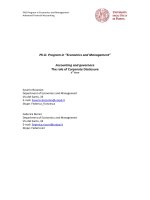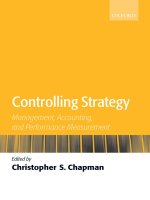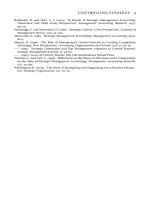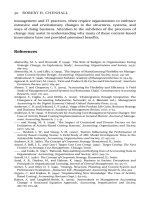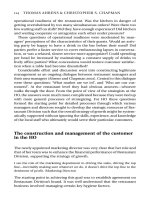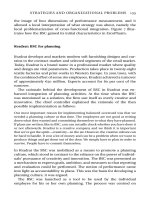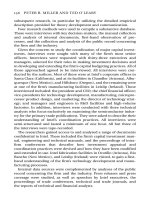Controlling strategy management accounting and performance measurement oxford
Bạn đang xem bản rút gọn của tài liệu. Xem và tải ngay bản đầy đủ của tài liệu tại đây (1.89 MB, 204 trang )
............................................................
Controlling Strategy
............................................................
This page intentionally left blank
............................................................
Controlling Strategy
Management, Accounting,
and Performance Measurement
Edited by
CHRISTOPHER S. CHAPMAN
1
3
Great Clarendon Street, Oxford ox2 6dp
Oxford University Press is a department of the University of Oxford.
It furthers the University’s objective of excellence in research, scholarship,
and education by publishing worldwide in
Oxford New York
Auckland Cape Town Dar es Salaam Hong Kong Karachi
Kuala Lumpur Madrid Melbourne Mexico City Nairobi
New Delhi Shanghai Taipei Toronto
With offices in
Argentina Austria Brazil Chile Czech Republic France Greece
Guatemala Hungary Italy Japan Poland Portugal Singapore
South Korea Switzerland Thailand Turkey Ukraine Vietnam
Oxford is a registered trade mark of Oxford University Press
in the UK and in certain other countries
Published in the United States
by Oxford University Press Inc., New York
ß Oxford University Press 2005
The moral rights of the author have been asserted
Database right Oxford University Press (maker)
First published 2005
All rights reserved. No part of this publication may be reproduced,
stored in a retrieval system, or transmitted, in any form or by any means,
without the prior permission in writing of Oxford University Press,
or as expressly permitted by law, or under terms agreed with the appropriate
reprographics rights organization. Enquiries concerning reproduction
outside the scope of the above should be sent to the Rights Department,
Oxford University Press, at the address above
You must not circulate this book in any other binding or cover
and you must impose the same condition on any acquirer
British Library Cataloguing in Publication Data
Data available
Library of Congress Cataloguing in Publication Data
Data available
Typeset by SPI Publisher Services, Pondicherry, India
Printed in Great Britain
on acid-free paper by
Biddles Ltd., King’s Lynn, Norfolk
ISBN 0-19-928323-0 978-019-928323-1
ISBN 0-19-928063-0 978-019-928063-6 (pbk.)
1 3 5 7 9 10 8 6 4 2
This book is humbly dedicated to
MY FATHER
for his encouragement, support, and wisdom over
many years.
This page intentionally left blank
............................................................
CONTENTS
List of Figures
List of Tables
Notes on Contributors
ix
x
xi
1.
Controlling Strategy
Christopher S. Chapman
2.
Content and Process Approaches to Studying Strategy and
Management Control Systems
Robert H. Chenhall
10
The Promise of Management Control Systems for
Innovation and Strategic Change
Tony Davila
37
4.
What Do We Know about Management Control Systems
and Strategy?
Kim Langfield-Smith
62
5.
Moving From Strategic Measurement to Strategic
Data Analysis
Christopher D. Ittner & David F. Larcker
86
6.
Management Control Systems and the Crafting of Strategy:
A Practice-Based View
Thomas Ahrens & Christopher S. Chapman
3.
7.
Strategies and Organizational Problems: Constructing
Corporate Value and Coherence in Balanced Scorecard
Processes
Allan Hansen & Jan Mouritsen
1
106
125
viii
8.
CONTENTS
Capital Budgeting, Coordination, and Strategy:
A Field Study of Interfirm and Intrafirm Mechanisms
Peter B. Miller & Ted O’Leary
Index
151
183
............................................................
LIST OF FIGURES
1 Strategic data analysis process
2 Estimated elasticities from cross-sectional regressions
of convenience store food sales ($US) on gasoline sales (gallons)
3 Analysis of the drivers of food sales profitability in convenience
stores
4 Computer manufacturer study linking customer satisfaction
scores to subsequent product recommendations
5 Analysis linking employee-related measures to customer
purchase behaviour in a financial services firm
6 Restaurant Division organization chart
7 Organizational problems and the BSC in ErcoPharm
8 Organizational problems and the BSC in Kvadrat
9 Organizational problems and the BSC in Columbus IT
10 Organizational problems and the BSC in BRFkredit
11 Components in translations of corporate value and coherence
12 Components of the 0.25-micron technology generation whose
design Intel sought to coordinate at intra- and interfirm levels.
Components developed by other firms are indicated by
shaded boxes.
88
90
92
94
96
110
134
137
140
142
145
170
............................................................
LIST OF TABLES
1
2
3
4
Strategic concepts for MCS
A model of MCS for innovation strategy
Information on formal fieldwork activity
Corporate value, coherence, and strategic performance
measurement in four cases
5 Estimated manufacturing cost of a failure to coordinate
process generation and product designs
6 Required rates and directions of change in individual design
variables to achieve coordinated and system-wide innovation
7 Relative performance indicators for the Pentium II microprocessor
42
47
111
131
162
166
174
............................................................
NOTES ON CONTRIBUTORS
Thomas Ahrens, University of Warwick
Christopher S. Chapman, University of Oxford
Robert H. Chenhall, Monash University & James Cook University
Tony Davila, Stanford University & IESE Business School
Allan Hansen, Copenhagen Business School
Christopher D. Ittner, University of Pennsylvania
Kim Langfield-Smith, Monash University
David F. Larcker, University of Pennsylvania
Peter B. Miller, London School of Economics and Political Science
Jan Mouritsen, Copenhagen Business School
Ted O’Leary, Manchester Business School & University of Michigan
This page intentionally left blank
Controlling Strategy
Christopher S. Chapman
The relationship between management control
systems and strategy
The chapters that follow develop our understanding of the relationship
between management control systems (MCS) and strategy through the
synthesis of a considerable range of work in the fields of strategy and
management accounting. As will be seen, such an easy labelling here
belies the breadth and complexity of ideas underlying those labels
(Miller 1998; Whittington 2003). A part of the motivation for this volume
is to demonstrate something of the range of perspectives from which
controlling strategy can be seen to be important. This volume does
not attempt a complete inventory of possible perspectives, however.
Instead, a common thread unites the diverse theoretical syntheses and
analyses of field material presented in the contributions that follow.
Both individually and collectively the chapters draw out in detail various
ways in which MCS may actively build and sustain valuable strategic
roles.
Except in highly controlled and stable environments it has become
commonplace to think of MCS as at best irrelevant, more frequently as
damaging (Chapman 1997). Yet, there is another view, taken forward in
this volume, that MCS can enable innovative strategic responses in
contemporary, unstable environments (e.g. Simons 1995; Chapman
1998; Ahrens and Chapman 2002, 2004). We hope this book will contribute to the emergence of a clearer and richer discussion of the strategic
nature of MCS.
In the 1950s and 1960s management accounting techniques were seen
as effective means of organizational coordination and control. Within
firms and organizations, management accounting played a significant
role through the disciplining effects of standard costing, variance analysis, and related systems (Anthony 1965). The increasing sophistication
(aspirations) of corporate planning activities brought budgets greater
prominence and prestige as the practical and effective toolkit for implementing organizational strategy. Whilst difficulties were clearly acknowledged (Argyris 1953; Ridgway 1956), discussions of strategic planning
2
CHRISTOPHER S. CHAPMAN
during this period were naturally couched in terms of accounting measurements and systems (Norman 1965). New technologies were expected
to further enhance the role of management accounting (Diebold 1965).1
By the 1980s, however, management accounting was subject to widespread and sustained critique (Hayes and Abernathy 1980; Johnson and
Kaplan 1987).
Against the backdrop of the activities of organizations such as Slater
Walker in the UK in the 1960s and 1970s it is easy to see why critiques of
accounting were frequently couched not simply as a failure to consider
new priorities, but as a more fundamental incompatibility with them.
Hostile takeovers and asset-stripping had given an unattractive, even
pathological, slant to the idea of financial management (e.g. Roberts
1990). In the 1980s it became increasingly unclear that ‘managing by the
numbers’ was at all desirable (e.g. Ezzamel et al. 1990). Goold and
Campbell (1987) in their influential book outlined three basic styles of
corporate control: financial control, strategic planning, and strategic
control. Whilst providing unequivocal targets and a clear framework
for up-or-out management development, financial control was seen to
generate a focus on the short run over the strategic, inhibiting integrated
behaviour between business units, and ran the risk of engendering a
plethora of dysfunctional behaviours.
At least a part of the problem seems to have lain in the professional
organization of management accounting practice. Management
accounting practitioners emerged during the twentieth century as a
significant, professionally organized group with an increasingly sophisticated (at least in their own terms) body of knowledge (Armstrong 1985).
Their success in institutionalizing management accounting practices
as they became more numerous and more influential provided a protective bubble for their work. In the absence of the detailed operational
understanding that had informed its development, management
accounting came to be seen as a collection of dangerous and misleading abstractions (Armstrong and Jones 1992). Its focus held on old
issues through institutional inertia; it was unclear that management
accounting was capable of developing responses to new strategic
priorities such as quality, just in time, or zero defects (Johnson and
Kaplan 1987).
1
Interestingly, technology was an area in which Johnson and Kaplan (1987: 6) remained
optimists: ‘The computing revolution of the past two decades has so reduced information
collection and processing costs that virtually all technical barriers to design and implemention of effective management accounting systems have been removed.’
CONTROLLING STRATEGY
3
In fact, recent decades have seen many developments in management
accounting. Dent (1990) in helping to open up the study of strategy and
management control noted that responses to Johnson and Kaplan’s
critique (1987) of the strategic usefulness of management accounting
might be analysed in terms of two broad groupings. On the one hand
there have been calls to refine the nature of management accounting
practice (largely from accountants), and on the other there have been
calls for its abandonment (from pretty much every one else)—a basic
dichotomy that Hansen et al. (2003) have recently drawn upon in their
study of budgeting innovations.
In terms of calls for development, one early response was the specific
attempt to draw strategy into the realm of accounting practice (Bromwich 1990).2 Rather than seeking to establish a new field of accounting
practice, others worked within existing accounting paradigms, seeking
to bring on board new strategic priorities (e.g. Cheatham and Cheatham
1996). Costing techniques were substantially reworked with the introduction of activity-based costing (ABC) (e.g. Cooper and Kaplan 1992).
Still others sought to develop old techniques such as residual income
(Bromwich and Walker 1998).
These various innovations have not met with unqualified endorsement. Budgetary control remains subject to widespread and sustained
critique (see Hope and Fraser (2003) for a recent and high-profile example). Recent studies that sought to track the development of strategic
management accounting practices found little use of the term, and
limited application of the techniques, noting some uncertainty as to
what exactly strategic management accounting might be (Tomkins and
Carr 1996; Guilding et al. 2000; Roslender and Hart 2003). High-profile
and active authors such as Goldratt and Cox (1992) argued strongly
against the benefits of ABC, and many surveys on the subject report its
limited take-up, poor performance, and subsequent abandonment as an
organizational practice (Innes et al. 2000). Analysis of the success of
economic value–based measures are also mixed (e.g. O’Hanlon and
Peasnell 1998; Kleiman 1999). Whilst there might be an emerging consensus that such measures help provide a benchmark for quantifying
strategic success, it is often seen to be difficult to link such measures to
strategy directly. As such, their potential as systems of strategic control
remains open to question.
2
The term strategic management accounting had in fact been coined a decade earlier
with the call to introduce more management accounting into marketing work (Simmonds
1981).
4
CHRISTOPHER S. CHAPMAN
Whilst it too has its fair share of detractors, the most explicit and
direct contemporary claims to recapture the strategic significance of
management control practice are based around the development of
the balanced scorecard (BSC) (e.g. Kaplan 2001a, b), a technique that
started as a relatively straightforward call for greater levels of nonfinancial performance measurement (Kaplan and Norton 1992). Whilst
the BSC seems ubiquitous it remains curiously flexible and undefined
(see Hansen and Mouritsen, this volume), making it problematic as the
conceptual basis for a re-analysis of the relationship between strategy
and MCS.
Parallel to these concerns in accounting literature, recent developments in strategy literature are suggestive of new ways of considering
the relationship between strategy and MCS. Recent interest in hypercompetitive environments has resulted in a reconceptualization of
the strategy-making process from an episodic to a continuous endeavour (e.g. Brown and Eisenhardt 1997). The resource-based view on
strategy has been an important development to relate organizational
missions with organizational capabilities by introducing the notion of
routines to the strategy debate (e.g. Johnson et al. 2003). The idea is that
strategic capabilities are grounded in day-to-day organizational action.
Despite Mintzberg’s much earlier contribution (1987) on this topic
the relationship between strategy-making by senior management and
the day-to-day activity is only beginning to be systematically explored
by strategists (Marginson 2002; Johnson et al. 2003; Whittington
2003; Feldman 2004). The emphasis on the daily routine of strategymaking is suggestive of a very different role for MCS than the previously
predominant model of straightforward implementation of strategy (e.g.
Simons 1991).
Explicit analysis of the role of MCS in the strategy literature has not
stood still during this upheaval in the status of management accounting.
Schreyo¨gg and Steinmann (1987) and Lorange et al. (1986) are examples
of early attempts to move beyond simple cybernetic models of control
(Anthony 1965). More recently still there has been further elaboration.
Muralidharan (1997), for example, carefully distinguishes between strategic control and management control, developing a clearer framework
of roles. MCS remain strategically passive however. There is a growing
tradition of studies in the accounting literature that speaks directly to
emerging concerns in strategy literature (e.g. Roberts 1990; Simons 1990;
Ahrens 1997; Mouritsen 1999; Briers and Chua 2001; Ahrens and Chapman 2002, 2004; Malmi and Ikaheimo 2003; Preston et al. 1992). The
careful consideration of the relationship between ideas on strategy and
CONTROLLING STRATEGY
5
the details of day-to-day management control activity underpins much
of the analysis of more emphatically active and strategically constitutive
roles for management control systems contained in the various contributions to this volume.
The chapter by Chenhall begins with a broad overview of the ways in
which the issue of strategy has been theorized by strategists. After
outlining the distinction between content and process approaches, the
chapter goes on to bring out some of the ways in which the study of the
relationship between MCS and strategy might benefit from research that
synthesizes ideas from both perspectives. A number of these issues are
addressed in subsequent chapters. For example, the role of consultants
is discussed in Hansen and Mouritsen’s chapter; organizational inertia
and institutional pressures are seen to undermine attempts at data
analysis in Ittner and Larcker’s chapter. Chenhall also begins to outline
the ways in which MCS may play a role in organizational learning and
change, both areas in which they have not traditionally been expected to
play a significant role.
Davila systematically develops a framework for understanding the
role of MCS in managing innovation and change in organizations. Beginning with a review of the theoretical underpinnings of thinking on
the subject, his chapter goes on to make the point that whilst innovation
is frequently seen as something external to the organization, the careful
use of MCS can play a vital role in developing and shaping innovation.
The analysis moves beyond traditional theorizing in exploring the various roles that MCS might play in either a structural or a strategic
context, depending on whether the intention is to refine or replace
existing strategy.
Langfield-Smith sketches the contours of the empirical literature on
the relationship between MCS and strategy, highlighting areas for future
research. Through the detailed discussion of selected studies she demonstrates that the extant literature concerning the BSC, and capital
budgeting in particular, highlights the difficulties of incorporating strategy into management control activity. Two subsequent chapters in this
volume demonstrate through fieldwork the complex ways in which MCS
can inform strategy.
Ittner and Larcker, drawing on the results of a range of studies and
their own fieldwork, unpack the ways in which strategic data analysis
plays a central role in supporting (or, done wrong, undermining) the
communication of strategic assumptions, the identification and measurement of strategic value drivers, processes of resource allocation, and
target setting. Their analysis has clear implications for situations in
6
CHRISTOPHER S. CHAPMAN
which MCS are intended as mechanisms for the implementation of
strategy. Along with the other chapters, it demonstrates the ways in
which strategic data analysis might play a central role in redefining
strategic agendas (both negatively by challenging previously untested
assumptions and positively by refining them).
Ahrens and Chapman draw on contemporary developments in social
theory around notions of practice. In the light of these they draw out of
their study of marketing analysis in a restaurant chain the ways in which
MCS simultaneously report on external phenomena as they serve to
render them amenable to manipulation according to internal agendas.
For example, we see the ways in which ‘the customer’ is at once analysed in terms of their dining habits, and becomes established as an
ideal through financial analysis.
Hansen and Mouritsen, likewise, are concerned with the ways in
which MCS, and the BSC in particular, provides organizations with a
framework through which they can pursue their pre-existing control
and strategic agendas. Through a series of studies of scorecard implementations we see that far more is at stake than the adoption of a simple
approach for strategy implementation.
Finally Miller and O’Leary study the ways in which MCS support
intra- and interorganizational coordination in the technologically and
environmentally uncertain context of Intel. Here again, the detailed
study of processes of management control, analysed through the lens
of complementarity theory, takes us beyond simple cybernetic models
affirming the diversity and subtlety of management control as a means
of controlling strategy.
The discussions of management control and strategy in this volume
help bring together insights from these various fields, helping to consolidate our understanding of the relationship thus far, as well as helping to map more clearly the areas in which we remain unclear. A
consistent theme running through the chapters is that traditional
understandings of the relationship between MCS and strategy is at
best limited in scope. Traditional models frequently argue against the
benefits of MCS in environments and settings in which they nonetheless
remain ubiquitous. The chapters that follow develop grounds for understanding why their continued presence may be more than a question of
pathological organizational choice. Reviewing what we do know, the
chapters that follow more importantly open up new questions at the
same time as they suggest new ways of asking old ones. The promise is
the development of a far richer understanding of the relationship between MCS and strategy.
CONTROLLING STRATEGY
7
References
Ahrens, T. (1997). ‘Strategic Interventions of Management Accountants: Everyday Practice
of British and German Brewers’, European Accounting Review, 6: 557–88.
—— and Chapman, C. S. (2002). ‘The Structuration of Legitimate Performance Measures
and Management: Day-to-Day Contests of Accountability in a U.K. Restaurant Chain’,
Management Accounting Research, 13(2): 1–21.
—— —— (2004). ‘Accounting for Flexibility and Efficiency: A Field Study of Management
Control Systems in a Restaurant Chain’, Contemporary Accounting Research, 21(2): 271–
301.
Anthony, N. (1965). Management Control Systems, 3rd edn. Boston, MA: Harvard Business
School Press.
Argyris, C. (1953). ‘Human Problems with Budgets’, Harvard Business Review, 31(1): 97–110.
Armstrong, P. (1985). ‘Changing Management Control Strategies: The Role of Competition
between Accountancy and other Organisational Professions’, Accounting, Organizations
and Society, 10(2): 129–48.
—— and Jones, C. (1992). ‘The Decline of Operational Expertise in the Knowledge-Base of
Management Accounting’, Management Accounting Research, 3: 53–75.
Briers, M. and Chua, W. F. (2001). ‘The Role of Actor Networks and Boundary Objects in
Management Accounting Change: A Field Study of an Implementation of Activity-Based
Costing’, Accounting, Organizations and Society, 26(3): 237–69.
Bromwich, M. (1990). ‘The Case for Strategic Management Accounting: The Role of
Accounting Information for Strategy in Competitive Markets’, Accounting, Organizations
and Society, 13(1/2): 27–46.
—— and Walker, S. (1998). ‘Residual Income Past and Future’, Management Accounting
Research, 9(4): 391–419.
Brown, S. and Eisenhardt, K. M. (1997). ‘The Art of Continuous Change: Linking Complexity
Theory and Time-Paced Evolution in Relentlessly Shifting Organizations’, Administrative
Science Quarterly, 42(1): 1–34.
Chapman, C. S. (1997). ‘Reflections on a Contingent View of Accounting’, Accounting,
Organizations and Society, 22(2): 189–205.
—— (1998). ‘Accountants in Organisational Networks’, Accounting, Organizations and Society, 23(8): 737–66.
Cheatham, C. and Cheatham, L. (1996). ‘Redesigning Cost Systems: Is Standard Costing
Obsolete?’, Accounting Horizons, 10(4): 23–31.
Cooper, R. and Kaplan, R. S. (1992). ‘Activity-Based Systems: Measuring the Cost of Resource Usage’, Accounting Horizons (Sept.): 1–13.
Dent, J. F. (1990). ‘Strategy, Organization and Control: Some Possibilities for Accounting
Research’, Accounting, Organizations and Society, 3–26.
Diebold, J. (1965). ‘What’s Ahead in Information Technology’, Harvard Business Review,
43(5): 76–82.
Ezzamel, M., Hoskin, K. W., and Macve, R. H. (1990). ‘Managing It All by Numbers: A Review
of Johnson and Kaplan’s Relevance Lost’, Accounting and Business Research, 20(78):
153–66.
Feldman, M. S. (2004). ‘Resources in Emerging Structures and Processes of Change’,
Organization Science, 15(3): 295–309.
Goldratt, E. and Cox, J. (1992). The Goal: A Process of Ongoing Improvement, 2nd edn.
Croton-on-Hudson, NY: North River Press.
Goold, M. and Campbell, A. (1987). Strategies and Styles : The Role of the Centre in Managing
Diversified Corporations. Oxford: Blackwell.
8
CHRISTOPHER S. CHAPMAN
Guilding, C., Cravens, K. S., and Tayles, M. (2000). ‘An International Comparison of
Strategic Management Accounting Practices’, Management Accounting Research, 11(1):
113–35.
Hansen, S., Otley, D., and Van der Stede, W. (2003). ‘Practice Developments in Budgeting:
An Overview and Research Perspective’, Journal of Management Accounting Research, 15:
49–70.
Hayes, R. H. and Abernathy, W. (1980). ‘Managing Our Way to Economic Decline’, Harvard
Business Review, 58(4): 67–77.
Hope, J. and Fraser, R. (2003). ‘Who Needs Budgets?’, Harvard Business Review, 81(2):
108–16.
Innes, J., Mitchell, F., and Sinclair, D. (2000). ‘Activity-Based Costing in the U.K.’s Largest
Companies: A Comparison of 1994 and 1999 Survey Results’, Management Accounting
Research, 11(3): 349–62.
Johnson, G., Melin, L., and Whittington, R. (2003). ‘Guest Editors’ Introduction: Micro
Strategy and Strategizing: Towards an Activity-Based View’, Journal of Management
Studies, 40(1): 3–22.
Johnson, H. and Kaplan, R. (1987). Relevance Lost: The Rise and Fall of Management
Accounting. Boston, MA: Harvard Business School Press.
Kaplan, R. S. (2001a). ‘Transforming the Balanced Scorecard from Performance Measurement to Strategic Management: Part I’, Accounting Horizons, 15(1): 87–105.
—— (2001b). ‘Transforming the Balanced Scorecard from Performance Measurement to
Strategic Management: Part II’, Accounting Horizons, 15(2): 147–60.
—— and Norton, D. P. (1992). ‘The Balanced Scorecard—Measures that Drive Performance’,
Harvard Business Review (Jan.–Feb.): 71–9.
Kleiman, R. (1999). ‘Some Evidence on EVA Companies’, Journal of Applied Corporate
Finance, 12: 88–91.
Lorange, P., Scott Morton, M. F., and Ghoshal, S. (1986). Strategic Control Systems, St. Paul,
MN: West Publishing.
Malmi, T. and Ikaheimo, S. (2003). ‘Value-Based Management Practices—Some Evidence
from the Field’, Management Accounting Research, 14(3): 235–54.
Marginson, D. (2002). ‘Management Control Systems and Their Effects on Strategy Formation at Middle-Management Levels: Evidence from a UK Organization’, Strategic
Management Journal, 23: 1019–31.
Miller, P. (1998). ‘The Margins of Accounting’, in M. Callon (ed.), The Laws of the Markets.
Oxford: Blackwell Publishers, 174–93.
Mintzberg, H. (1987). ‘Crafting Strategy’, Harvard Business Review, 65(4): 66–75.
Mouritsen, J. (1999). ‘The Flexible Firm: Strategies for a Subcontractor’s Management
Control’, Accounting, Organizations and Society, 24(1): 31–56.
Muralidharan, R. (1997). ‘Strategic Control for Fast-Moving Markets: Updating the Strategy
and Monitoring Performance’, Long Range Planning, 30(1): 64–73.
Norman, B. (1965). ‘Strategic Planning in Conglomerate Companies’, Harvard Business
Review, 43(3): 79–92.
O’Hanlon, J. and Peasnell, K. (1998). ‘Wall Street’s Contribution to Management Accounting: The Stern Stewart EVA(R) Financial Management System’, Management Accounting
Research, 9(4): 421–44.
Preston, A., Cooper, D., and Coombs, R. (1992). ‘Fabricating Budgets: A Study of the
Production of Management Budgeting in the National Health Service’, Accounting,
Organizations and Society, 17(6): 561–93.
Ridgway, V. (1956). ‘Dysfunctional Consequences of Performance Measurement’, Administrative Science Quarterly, 1(2): 240–7.
Roberts, J. (1990). ‘Strategy and Accounting in a U.K. Conglomerate’, Accounting, Organizations and Society, 15: 107–26.
CONTROLLING STRATEGY
9
Roslender, R. and Hart, S. J. (2003). ‘In Search of Strategic Management Accounting:
Theoretical and Field Study Perspectives’, Management Accounting Research, 14(3):
255–79.
Schreyo¨gg, G. and Steinmann, H. (1987). ‘Strategic Control: A New Perspective’, Academy of
Management Review, 12(1): 91–103.
Simmonds, K. (1981). ‘Strategic Management Accounting’, Management Accounting, 59(4):
26–9.
Simons, R. (1990). ‘The Role of Management Control Systems in Creating Competitive
Advantage: New Perspectives’, Accounting, Organizations and Society, 15(1/2): 127–43.
—— (1991). ‘Strategic Orientation and Top Management Attention to Control Systems’,
Strategic Management Journal, 12: 49–62.
—— (1995). Levers of Control. Boston, MA: Harvard Business School Press.
Tomkins, C. and Carr, C. (1996). ‘Reflections on the Papers in this Issue and a Commentary
on the State of Strategic Management Accounting’, Management Accounting Research,
7(2): 271–80.
Whittington, R. (2003). ‘The Work of Strategizing and Organizing: For a Practice Perspective’, Strategic Organization, 1(1): 117–25.
Content and Process Approaches to
Studying Strategy and Management
Control Systems
Robert H. Chenhall
This chapter is concerned with developing our understanding of the role
of management control systems (MCS) in formulating and implementing strategy. Strategy has become a dominant influence in the study of
organizations. Researchers in areas such as economics (Milgrom and
Roberts 1992; Seth and Thomas 1994), human resource management
(Miller 1991; Kochan and Osterman 1994), information technology (IT)
(Grover et al. 1997), and organizational behaviour (Knights and Morgan
1991; Rowe et al. 1994; Rouleau and Seguin 1995) all seek to understand
the ways in which their disciplines assist in understanding how managers use strategy to achieve desired outcomes. Management accounting has been informed by these literatures to such an extent that
strategic management accounting is seen by many commentators as
the key to understanding the effective design and implementation of
MCS (Simmonds 1981; Bromwich 1990; Ward 1992).
Costing has developed a strategic focus whereby activity-based cost
management (ABCM) has moved from refining the attribution of fixed
costs to cost objects to systems that link costs and value drivers to
alternate strategies, thereby enabling cost–benefit analysis and an
understanding of process requirements to effect strategies (Shank and
Govindarajan 1995; Kaplan and Cooper 1998). Performance measurement has evolved from enhancing the usefulness of performance measures by including both financial and non-financial measures to more
complex systems based on a balanced suite of measures that provides
strategic performance management, including causal maps that show
the operational implications for different strategies (McNair et al. 1990;
Kaplan and Norton 1992, 1996, 2001). More recently, attention has been
focused on how MCS can be used interactively to assist in developing
responsiveness throughout the organization to the strategic uncertainties facing the organization (Simons 1995, 2000). These advances are
reflected in the emphasis given in most contemporary management
accounting textbooks to a strategic orientation to management control.
CONTENT AND PROCESS APPROACHES
11
This chapter draws on the distinction between content and process
approaches to help develop understanding of existing strategy-based
MCS research and provide a unifying perspective for thinking about a
future research agenda. The potential contribution is to clarify the different purposes of content and process approaches, thereby opening debate
to reflect on past findings in management control research. Also, a variety
of issues concerning both content and process are presented as key areas
for future research. First, the difference between content and process
approaches is discussed. Second, the ways in which management control
has been related to content approaches is examined and the potential for
future research in this area explored. Third, process approaches are examined, again with an eye to the extant literature and future directions.
Finally, the issue of strategic change is discussed to show how both content
and process approaches can help consideration of this research agenda.
Content and process approaches: an overview
A precise definition of strategy is illusive. At one extreme, strategy is
defined as the careful articulation of objectives and plans for achieving
these objectives (Steiner 1969; Andrews 1980; Ansoff 1987). This suggests a
highly rational, systematic approach involving formalized procedures
that integrate decision-making throughout the organization to achieve
desired outcomes. The strategy function involves articulating ‘intended
strategies’ and formulating deliberate policies to achieve these strategies
(Mintzberg 1994: 24). This process results in the formulation of a ‘strategic
position’ (Porter 1980, 1985). On the other hand, strategy can be identified
as a pattern of behaviour that evolves over time, based on a perspective or
understanding of a way to do things (Jelinek 1979). This definition recognizes that strategy is a process where ideas may emerge in ‘unintended’
ways involving incremental processes (Quinn 1980; Mintzberg 1994: 25).
The distinction between formal rational approaches and more informal incremental approaches is a useful first step to describe the difference between content and process approaches (Fahey and Christensen
1986; Leong et al. 1990). Strategic content approaches tend to be concerned with the product of the strategy process. They aim to identify what
is, or what should be, the strategy to lead to optimal organizational
performance. This involves describing the effective competitive positioning of the organization and access to resources within the organization’s
environment. There is an implicit assumption that individuals behave
12
ROBERT H. CHENHALL
rationally and particular strategies can be identified as appropriate to
specific situations. Strategy is seen to follow a logical, linear process of
strategy formulation, analysis, and implementation. Strategy content
research tends to provide snapshots of ideal strategies, or optimal combinations of strategies for organizations facing different settings. Strategic change is typically categorized as being either radical or incremental
and the aim is to identify ideal guidelines to assist in managing these
different types of change (Kanter et al. 1992; Phillips 1992; Kotter 1996).
Process approaches are also concerned with the content of strategies.
However, the interest is in how processes influence the content of
strategies, and how does the content influence process (Van de Ven
1995). What are the dynamic relationships between strategic position,
resources and outcomes? How is, and how should, strategy be formulated? Who is involved in the strategy process and how do individual
differences have effects? What causes strategy to be changed and what is
involved in this process? Given identification of a desired strategy, what
processes occur to affect the strategy? Process approaches focus on the
incremental strategic processes that involve a messy interlinking between strategy formulation and implementation, with unintended ideas
emerging during implementation. Similarly, process approaches are
alert to the possibility that inherent resistance derived from organizational and behavioural impediments may obstruct strategic change.
Finally, both content and process approaches may be applied to
understanding strategy at many levels: corporate, business unit, functional, and network. While strategies have effects across levels within
the organization, the nature of the issues differs. At the corporate level,
strategy involves questions of what is the nature of the business, such as
the major industries within which the organization operates. At the
business-unit level, strategy involves more precise issues of products
and technologies, while at the functional level strategy is concerned
with functions such as manufacturing and marketing. Network strategies recognize that many strategies may involve cooperative rather
than competitive relationships with other firms and involve strategic
alliances and joint ventures.
Content approaches
Content approaches to strategy aim to identify practices that are associated with enhanced performance. Approaches to formulating and


